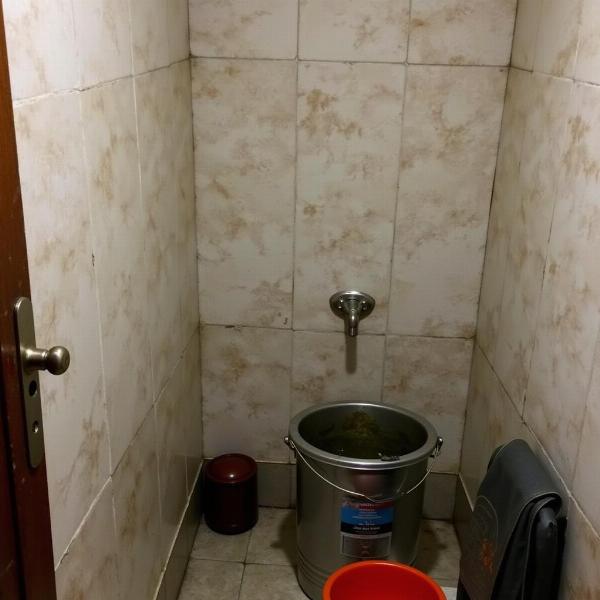Understanding the nuances of everyday phrases like “I am going to take a bath” can be crucial for anyone learning Hindi. This seemingly simple phrase has several Hindi translations, each with slightly different connotations and appropriate usage depending on the context. Knowing which translation to use will make your Hindi sound more natural and demonstrate a deeper understanding of the language.
Different Ways to Say “I Am Going To Take a Bath” in Hindi
Several Hindi phrases can convey the meaning of “I am going to take a bath.” Here’s a breakdown of the most common ones:
-
Main nahane ja raha/rahi hoon (मैं नहाने जा रहा/रही हूँ): This is perhaps the most common and versatile translation. “Nahana (नहाना)” means “to bathe,” and “ja raha/rahi hoon (जा रहा/रही हूँ)” signifies “I am going to.” The gendered suffixes “raha” (for males) and “rahi” (for females) are essential for grammatical correctness.
-
Main snan karne ja raha/rahi hoon (मैं स्नान करने जा रहा/रही हूँ): “Snan (स्नान)” is a more formal and often religiously connotated term for bathing. This phrase is suitable for situations involving ritual purification or religious ceremonies.
-
Main gusl karne ja raha/rahi hoon (मैं ग़ुस्ल करने जा रहा/रही हूँ): “Gusl (ग़ुस्ल)” specifically refers to a ritual bath in Islam. Use this phrase only when discussing Islamic practices.
-
Main nahane wala/wali hoon (मैं नहाने वाला/वाली हूँ): This phrase translates to “I am about to take a bath.” It indicates imminence, suggesting the action is about to happen very soon. Again, the gendered suffixes “wala” (male) and “wali” (female) are crucial.
Choosing the Right Phrase
The best way to choose the right phrase depends entirely on the context. Are you talking about a daily routine, a religious ceremony, or an immediate action? Consider the following:
- Informal settings: “Main nahane ja raha/rahi hoon” is perfectly acceptable.
- Formal settings or religious contexts: “Main snan karne ja raha/rahi hoon” is more appropriate.
- Islamic contexts: “Main gusl karne ja raha/rahi hoon” is the correct choice.
- Expressing imminence: “Main nahane wala/wali hoon” is ideal.
Beyond the Basics: Cultural Significance of Bathing in India
Bathing in India goes beyond mere hygiene. It’s deeply intertwined with religious and cultural practices. From the holy dips in the Ganges to the daily ritual bath, water holds a purifying and symbolic significance. Understanding this cultural context adds another layer of meaning to the simple act of taking a bath.
What does “nahana” imply culturally?
“Nahana” often implies a full body wash, typically using a bucket and mug rather than a shower. This method is prevalent throughout India and is often seen as a more thorough and refreshing way to cleanse oneself.
Why is “snan” considered more formal?
“Snan” is associated with ritual purity and is often used in religious scriptures and ceremonies. This connection to religious practices elevates its formality.
 Traditional Indian Bathroom
Traditional Indian Bathroom
Conclusion
While “I am going to take a bath” seems like a straightforward phrase, its Hindi translations offer a glimpse into the rich cultural and linguistic tapestry of India. By understanding the nuances of each translation, you can communicate more effectively and demonstrate a deeper appreciation for the language. Remembering the context and choosing the appropriate phrase will enhance your communication and cultural understanding.
FAQ
-
What is the most common way to say “I am going to take a bath” in Hindi? The most common way is “Main nahane ja raha/rahi hoon (मैं नहाने जा रहा/रही हूँ).”
-
Is there a difference between “nahana” and “snan”? “Nahana” is a general term for bathing, while “snan” is often associated with ritual purity and religious ceremonies.
-
When should I use “gusl”? Use “gusl” only when referring to the ritual bath in Islam.
-
How do I say “I am about to take a bath”? You can say “Main nahane wala/wali hoon (मैं नहाने वाला/वाली हूँ).”
-
What is the cultural significance of bathing in India? Bathing in India is often connected to religious and cultural practices, symbolizing purification and renewal.
-
What is the typical way of bathing in India? Many people in India bathe using a bucket and mug, which is seen as a thorough and refreshing way to cleanse oneself.
-
Why is understanding the nuances of these phrases important? Understanding these nuances allows for more effective communication and demonstrates a deeper understanding of Hindi language and culture.
Meaning-Hindi.in is your one-stop solution for all your Hindi translation needs. We specialize in various translation services, including business and commercial document translation, certified and legal document translation, technical and user manual translation, website and localization translation, educational and academic document translation, express translation, and specialized translation services. For accurate and culturally sensitive translations, contact us at [email protected] or call us at +91 11-4502-7584. Meaning-Hindi.in is dedicated to bridging the language gap and facilitating seamless communication.